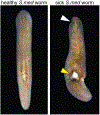Laboratory Maintenance and Propagation of Freshwater Planarians
- PMID: 33058563
- PMCID: PMC7941200
- DOI: 10.1002/cpmc.120
Laboratory Maintenance and Propagation of Freshwater Planarians
Abstract
Freshwater planarians are a powerful model organism for the study of animal regeneration, stem cell maintenance and differentiation, and the development and functions of several highly conserved complex tissues. At the same time, planarians are easy to maintain, inexpensive to propagate, and reasonably macroscopic (1 mm to 1 cm in length), making them excellent organisms to use in both complex academic research and hands-on teaching laboratories. Here, we provide a detailed description of how to maintain and propagate these incredibly versatile animals in any basic laboratory setting. © 2020 Wiley Periodicals LLC. Basic Protocol 1: Salt solution preparation Basic Protocol 2: Cleaning planarian housing Basic Protocol 3: Food preparation Basic Protocol 4: Feeding planarians Basic Protocol 5: Expansion and amplification of colony.
Keywords: Girardia; Schmidtea mediterranea; planarian; regeneration.
© 2020 Wiley Periodicals LLC.
Figures


References
-
- Accorsi A, Williams MM, Ross EJ, Robb SMC, Elliott SA, Tu KC, & Alvarado AS (2017). Hands-on classroom activities for exploring regeneration and stem cell biology with planarians. The American Biology Teacher, 79(3), 208–223. https://online.ucpress.edu/abt/article-abstract/79/3/208/18944
-
- Bahrs AM, & Wulzen R (1936). Nutritional Value for Planarian Worms of Vitamin Depleted Mammalian Tissues. In Experimental Biology and Medicine (Vol. 33, Issue 4, pp. 528–532). 10.3181/00379727-33-8438c - DOI
Publication types
MeSH terms
Substances
Grants and funding
LinkOut - more resources
Full Text Sources
Other Literature Sources
Medical

